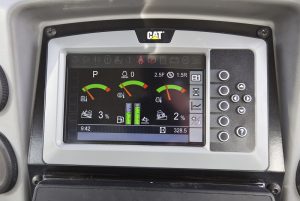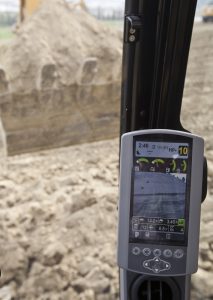
Caterpillar has revealed a host of electronic upgrades to equipment and services, as it seeks to provide operators with more production data and efficiency. Geoff Ashcroft reports.
Technology has an increasingly more important role to play when it comes to operating efficiency. That’s the message from US equipment giant Caterpillar, who recently took the wraps off a host of technology upgrades to its equipment and services, including machine control systems, as Caterpillar continues to find ways of dealing with operator skills shortages.
We’re not talking full autonomy just yet, but using technology that can assist and guide the operator, Cat is looking to fast-track the learning process for less experienced operators.
But is it technology for technology’s sake? Cat argues that low-tech machine control and guidance systems can boost productivity and efficiency, for those who have yet to gain experience from spending hundreds, if not thousands of hours in the seat.
As a result, it has extended its suite of Grade Technology packages with a host of low-tech systems that can now be found on dozers and excavators. The latest component for dozers is called Slope Assist, while excavators get Grade with Assist.
 Slope Assist is a low-tech machine assistance system that can automatically maintain blade angle without the need for an external laser or GPS reference.
Slope Assist is a low-tech machine assistance system that can automatically maintain blade angle without the need for an external laser or GPS reference.
It gives operators a taste of automated blade control systems and lets dozer owners put a toe in the GPS pond without having to invest heavily in full-on GPS systems.
So if you don’t already have 3D infrastructure, you won’t need to invest in it, to run this basic machine guidance system.
Slope Assist helps operators to reach their target slope by automatically maintaining the dozer blade’s established blade angles. This provides management of cross slope and main fall angles, and it has become a standard feature on D6K2, D6N and D6T, and is optional on smaller D4K2 and D5K2 models.
Eric Durand, Cat’s product application specialist believes systems such as Slope Assist and Grade with Assist are not a replacement for operating skills. He says they should be viewed as assistance mechanisms designed to help and guide operators.
“With Slope Assist for example, once you’ve set the angles on the monitor at the percentages you want, the dozer will follow and maintain the required slopes,” he says. “But you still need to control the cutting height – all it does is maintain angles that you choose to set.”
Eric goes on to explain that the integration of Slope Assist will enable operators to leave a far more level surface and it will help them to reach that finish much more easily. “Slope Assist avoids constantly having to work the blade lever to maintain the required blade position throughout a cut. And it’ is accurate to within one per cent,” he adds.
A new in-cab monitor shows the blade and machine angles as percentages, and the system can be run in Basic and Advanced modes. In either mode, the operator can select manual or automatic control.
Where manual control provides slope guidance while the operator maintains full control of the blade, automatic  control takes over the blade movement with extended functionality and lets you concentrate on machine travel and steering during a cut.
control takes over the blade movement with extended functionality and lets you concentrate on machine travel and steering during a cut.
When it comes to excavator technology, Grade with Assist is a semi-automatic boom and bucket control system that is currently available for the 323F excavator. And it enables operators – regardless of experience – to reach their target grade as much as 45 per cent faster than manual grading.
After entering a target depth into the system, and selecting ‘auto’, the operator simply needs to excavate the work area. Assist technology takes over as the bucket gets to within 100mm of the target depth. At this point, the system automatically adjusts boom up/down and bucket roll to maintain a constant bucket angle through the dig. This leaves the operator to control the stick-in speed, using the left-hand lever.
The system achieves a grading accuracy of within 2-3cm, says Caterpillar. Advantages include a reduction in over-digging – in ‘auto’ mode the system will not allow the bucket to pass through the target depth.
The operator continues to control the excavator in the normal way, with the automated system creating a much neater, smoother finish, in much less time.
It is possible to over-ride the system at any time, to excavate an obstruction for example, by pressing an over-ride button on the right-hand joystick.
Grade with Assist also allows you to pre-set a floor elevation, enabling you to neatly excavate a fall while trenching, for example. And the bucket angle can be recalled too, offering easy repeatability with repetitive bulk excavating tasks.
Cleverly, the system also lets you select a ceiling height to prevent the boom from being raised too high – useful when working in buildings, beneath bridges or power lines.
Grade with Assist has been developed to bridge the gap between a 2D indicate-only system, and a full-blown 3D system. It’s not the only technology that could benefit excavator operators – production measurement is another. This integrated on-board payload weighing system for excavators gives operators instant access to production data.
The payload system is shown on the machine’s monitor. It allows up to 10 different truck types to be stored, offering  individual payload values to be input, for the various types of truck in use. A status bar at the bottom of the screen shows current payload information, including truck payload, bucket payload, weigh status, truck count, truck status, remaining payload and bucket count.
individual payload values to be input, for the various types of truck in use. A status bar at the bottom of the screen shows current payload information, including truck payload, bucket payload, weigh status, truck count, truck status, remaining payload and bucket count.
With the truck target weight entered into the system, the operator simply needs to lift the loaded bucket smoothly. As the excavator is swung towards the truck, the weigh system beeps twice to indicate a shift in status from estimated bucket payload to an accurate payload.
After the bucket has been emptied, the weight is transferred to the truck payload indicator, while at the same time counting down any remaining payload. Additional audible alarms will sound on the next-to-last bucket, and the truck status indicator starts to turn green in the centre, indicating that the truck is almost full.
After the final bucket is weighed, the system will sound again to indicate a full load and the truck status icon turns completely green. If the bucket is filled with too much material, the truck status icon will turn red, indicating an over-load scenario.
The production measurement system can be interrupted at any time, if you need to temporarily stop loading. Caterpillar says the system accuracy is +/- 5 per cent, and, while it accepts the system is not good enough to use to sell aggregates, it does provide a useful means of weighing muck out of sites instead of over-loading eight-wheelers, for example.
For more information visit www.cat.com








